Air Gap Fiber Bragg Grating for Simultaneous Strain and Temperature Measurement
Abstract
1. Introduction
2. Sensor Structure and Sensing Principle
3. Experimental Results and Discussion
3.1. Experimental System
3.2. Strain Measurement Test
3.3. Temperature Test
3.4. Simultaneous Measurement of Strain and Temperature
4. Conclusions
Author Contributions
Funding
Institutional Review Board Statement
Informed Consent Statement
Data Availability Statement
Acknowledgments
Conflicts of Interest
References
- Choi, B.-H.; Kwon, I.-B. Residual strain sensor using Al-packaged optical fiber and Brillouin optical correlation domain analysis. Opt. Express 2015, 23, 6867–6877. [Google Scholar] [CrossRef]
- Jiang, T.; Ba, D.; Dong, Y. Online distributed strain measurement of fiber Michelson hydrophones based on DPP-BOTDA with a pulsed-probe wave. Opt. Express 2019, 27, 22375–22384. [Google Scholar] [CrossRef]
- Liu, L.; Ning, T.; Zheng, J.; Pei, L.; Li, J.; Cao, J.; Gao, X.; Zhang, C. High-sensitivity strain sensor implemented by hybrid cascaded interferometers and the Vernier-effect. Opt. Laser Technol. 2019, 119, 105591. [Google Scholar] [CrossRef]
- Singh, A.K.; Berggren, S.; Zhu, Y.; Han, M.; Huang, H. Simultaneous strain and temperature measurement using a single fiber Bragg grating embedded in a composite laminate. Smart Mater. Struct. 2017, 26, 115025. [Google Scholar] [CrossRef]
- De Oliveira, L.A.; de Sousa, F.B.; de Sousa, F.M.; Tavares, S.C.C.; Paschoal, W.; Costa, M.B.C. Prototype of a sensor for simultaneous monitoring of water level and temperature of rivers in the Amazon using FBG. Opt. Quantum Electron. 2022, 54, 731. [Google Scholar] [CrossRef]
- Zhang, W.; Luan, N. Air-silica core microstructured optical fiber-based SPR sensor for temperature and refractive index measurement. Results Phys. 2023, 53, 106976. [Google Scholar] [CrossRef]
- Li, R.; Tan, Y.; Chen, Y.; Hong, L.; Zhou, Z. Investigation of sensitivity enhancing and temperature compensation for fiber Bragg grating (FBG)-based strain sensor. Opt. Fiber Technol. 2019, 48, 199–206. [Google Scholar] [CrossRef]
- Frazao, O.; Ferreira, L.A.; Araújo, F.M.; Santos, J.L. Applications of fiber optic grating technology to multi-parameter measurement. Fiber Integr. Opt. 2005, 24, 227–244. [Google Scholar] [CrossRef]
- Su, D.; Qiao, X.; Chen, F.; Bao, W. Compact Dual Fiber Bragg Gratings for Simultaneous Strain and High-Temperature Measurement. IEEE Sens. J. 2019, 19, 5660–5664. [Google Scholar] [CrossRef]
- Wang, C.; Huang, Z.; Li, G.; Zhang, S.; Zhao, J.; Zhao, N.; Cai, H.; Zhang, Y. Simultaneous Temperature and Strain Measurements Using Polarization-Maintaining Few-Mode Bragg Gratings. Sensors 2019, 19, 5221. [Google Scholar] [CrossRef]
- Guo, K.; He, J.; Shao, L.; Xu, G.; Wang, Y. Simultaneous Measurement of Strain and Temperature by a Sawtooth Stressor-Assisted Highly Birefringent Fiber Bragg Grating. J. Light. Technol. 2020, 38, 2060–2066. [Google Scholar] [CrossRef]
- Kim, D.K.; Lee, S.-L.; Choi, S.; Kim, M.S.; Kim, J.; Han, J.; Lee, Y.W. Bend-Insensitive Simultaneous Measurement of Strain and Temperature based on Cascaded Long-Period Fiber Gratings Inscribed on a Polarization-Maintaining Photonic Crystal Fiber. J. Korean Phys. Soc. 2020, 76, 810–818. [Google Scholar] [CrossRef]
- Wu, H.; Lin, Q.; Jiang, Z.; Zhang, F.; Li, L.; Zhao, L. A temperature and strain sensor based on a cascade of double fiber Bragg grating. Meas. Sci. Technol. 2019, 30, 065104. [Google Scholar] [CrossRef]
- Zhang, S.; Geng, T.; Wang, S.; Niu, H.; Li, X.; Deng, S.; Wang, Z.; Sun, C.; Ma, Y.; Yang, W.; et al. High-Sensitivity Strain and Temperature Simultaneous Measurement Sensor Based on Multimode Fiber Chirped Long-Period Grating. IEEE Sens. J. 2020, 20, 14843–14849. [Google Scholar] [CrossRef]
- Guo, G. Superstructure fiber Bragg gratings for simultaneous temperature and strain measurement. Optik 2019, 182, 331–340. [Google Scholar] [CrossRef]
- Zhou, J.; Liao, C.; Wang, Y.; Yin, G.; Zhong, X.; Yang, K.; Sun, B.; Wang, G.; Li, Z. Simultaneous measurement of strain and temperature by employing fiber Mach-Zehnder interferometer. Opt. Express 2014, 22, 1680–1686. [Google Scholar] [CrossRef] [PubMed]
- Lu, C.; Su, J.; Dong, X.; Sun, T.; Grattan, K.T.V. Simultaneous Measurement of Strain and Temperature with a Few-Mode Fiber-Based Sensor. J. Light. Technol. 2018, 36, 2796–2802. [Google Scholar] [CrossRef]
- Gao, X.; Ning, T.; Zhang, C.; Xu, J.; Zheng, J.; Li, H.; Li, J.; Pei, L.; You, H. A dual-parameter fiber sensor based on few-mode fiber and fiber Bragg grating for strain and temperature sensing. Opt. Commun. 2020, 454, 124441. [Google Scholar] [CrossRef]
- Zhou, D.-P.; Wei, L.; Liu, W.-K.; Lit, J.W.Y. Simultaneous Strain and Temperature Measurement With Fiber Bragg Grating and Multimode Fibers Using an Intensity-Based Interrogation Method. IEEE Photonics Technol. Lett. 2009, 21, 468–470. [Google Scholar] [CrossRef]
- Kipriksiz, S.E.; Yuecel, M. Tilted fiber Bragg grating design for a simultaneous measurement of temperature and strain. Opt. Quantum Electron. 2021, 53, 1–15. [Google Scholar] [CrossRef]
- Her, S.-C.; Lin, W.-N. Simultaneous Measurement of Temperature and Mechanical Strain Using a Fiber Bragg Grating Sensor. Sensors 2020, 20, 4223. [Google Scholar] [CrossRef]
- Pashaie, R.; Vahedi, M. Simultaneous measurement of temperature and strain of a fixed composite cantilever using a π-PSFBG sensor. Opt. Quantum Electron. 2022, 54, 85. [Google Scholar] [CrossRef]
- Xiao, S.; Wu, B.; Wang, Z.; Jiang, Y. A peanut taper based Mach-Zehnder interferometric sensor for strain and temperature discrimination. Opt. Fiber Technol. 2022, 70, 102871. [Google Scholar] [CrossRef]
- Dey, K.; Buddu, R.; Roy, S. Performance of Etched Silica FBG for Simultaneous Strain Temperature Measurement. Silicon 2022, 14, 4349–4356. [Google Scholar] [CrossRef]
- Zhao, L.; Hao, S.; Chen, Y.; Zhao, E.; Xing, C.; Fan, J.; Tang, J. Simultaneous measurement of strain and temperature based on fiber sensor with Vernier effect. Opt. Laser Technol. 2023, 157, 108670. [Google Scholar] [CrossRef]
- Li, S.; He, W.; Tan, Q.; Liu, H.; Li, Z.; Zhu, L. High temperature and strain dual-parameters fiber sensing based on intermodal interference and femtosecond laser fabricated fiber Bragg grating. Phys. Scr. 2023, 98, 055505. [Google Scholar] [CrossRef]
- Dong, X.; Zhou, J.; Lin, X.; Li, S.; Qi, J.; Li, W. Novel tunable phase-shifted fiber Bragg grating implemented by adjusting gap between two fibers. In Photonics and Optoelectronics Meetings (POEM) 2008: Fiber Optic Communication and Sensors; SPIE: Philadelphia, PA, USA, 2009; pp. 370–377. [Google Scholar]
- Yang, Y.; Zhang, X.; Guo, J.-j.; Jin, W.; Yang, M. Gap FBG and its application in tunable narrow linewidth fiber laser. In Proceedings of the 22nd International Conference on Optical Fiber Sensors (OFS), Beijing, China, 15–19 October 2012. [Google Scholar]
- Gatti, D.; Galzerano, G.; Janner, D.; Longhi, S.; Laporta, P. Fiber strain sensor based on a π-phase-shifted Bragg grating and the Pound-Drever-Hall technique. Opt. Express 2008, 16, 1945–1950. [Google Scholar] [CrossRef]
- Jiang, Y.; Xu, J.; Yang, D.; Zhang, K.; Li, D.; Zhao, J. Miniaturized fiber Fabry-Perot interferometer for strain sensing. Microw. Opt. Technol. Lett. 2016, 58, 1510–1514. [Google Scholar] [CrossRef]
- Pevec, S.; Donlagic, D. Miniature all-fiber Fabry-Perot sensor for simultaneous measurement of pressure and temperature. Appl. Opt. 2012, 51, 4536–4541. [Google Scholar] [CrossRef]
- Yang, J.; Liu, H.; Wen, J.; Chen, L.; Shang, Y.; Chen, N.; Huang, S.; Wang, T.; Pang, F. Cylindrical vector modes based Mach-Zehnder interferometer with vortex fiber for sensing applications. Appl. Phys. Lett. 2019, 115, 051103. [Google Scholar] [CrossRef]
- Zhang, X.; Peng, W.; Shao, L.-Y.; Pan, W.; Yan, L. Strain and temperature discrimination by using temperature-independent FPI and FBG. Sens. Actuators A Phys. 2018, 272, 134–138. [Google Scholar] [CrossRef]
- Tian, J.; Jiao, Y.; Ji, S.; Dong, X.; Yao, Y. Cascaded-cavity Fabry-Perot interferometer for simultaneous measurement of temperature and strain with cross-sensitivity compensation. Opt. Commun. 2018, 412, 121–126. [Google Scholar] [CrossRef]
- Zhang, G.; Ge, Q.; Wang, H.; Wu, X.; Yu, B. Simultaneous temperature and strain measurement using TCF based Mach-Zehnder interferometer. Opt. Fiber Technol. 2021, 67, 102687. [Google Scholar] [CrossRef]
- Pan, Y.; Liu, T.; Jiang, J.; Liu, K.; Wang, S.; Yin, J.; He, P.; Yan, J. Simultaneous Measurement of Temperature and Strain Using Spheroidal-Cavity-Overlapped FBG. IEEE Photonics J. 2015, 7, 2493724. [Google Scholar] [CrossRef]
- Yu, X.; Song, N.; Song, J. A novel method for simultaneous measurement of temperature and strain based on EFPI/FBG. Opt. Commun. 2020, 459, 125020. [Google Scholar] [CrossRef]
- Htein, L.; Gunawardena, D.S.; Leong, C.Y.; Tam, H.-Y. Bragg Gratings in Two-Core Rectangular Fiber for Discrimination of Curvature, Strain, and Temperature Measurements. IEEE Trans. Instrum. Meas. 2021, 70, 3035528. [Google Scholar] [CrossRef]
- Zhou, A.; Qin, B.; Zhu, Z.; Zhang, Y.; Liu, Z.; Yang, J.; Yuan, L. Hybrid structured fiber-optic Fabry-Perot interferometer for simultaneous measurement of strain and temperature. Opt. Lett. 2014, 39, 5267–5270. [Google Scholar] [CrossRef] [PubMed]
- Zhang, G.; Ge, Q.; Wang, H.S.; Wu, X.Q.; Yu, B.L. Simultaneous measurement of temperature and strain based on dual SPR effect in PCF. Opt. Laser Technol. 2019, 113, 46–51. [Google Scholar] [CrossRef]
- Zhang, G.; Ge, Q.; Wang, H.S.; Wu, X.Q.; Yu, B.L. Stress applying TPMF based sensor for simultaneous temperature and strain measurement. Optik 2022, 254, 168636. [Google Scholar] [CrossRef]
- Geng, T.; He, J.; Yang, W.; Chen, X.; An, M.; Sun, C.; Jin, X.; Yuan, L. Modal Interferometer Using Three-Core Fiber for Simultaneous Measurement Strain and Temperature. IEEE Photonics J. 2016, 8, 2585339. [Google Scholar] [CrossRef]
- Jiang, Y.; Liu, C.; Zhang, W.; Mao, D.; Yang, D.; Zhao, J. Multi-Parameter Sensing Using a Fiber Bragg Grating Inscribed in Dual-Mode Fiber. IEEE Photonics Technol. Lett. 2017, 29, 1607–1610. [Google Scholar] [CrossRef]
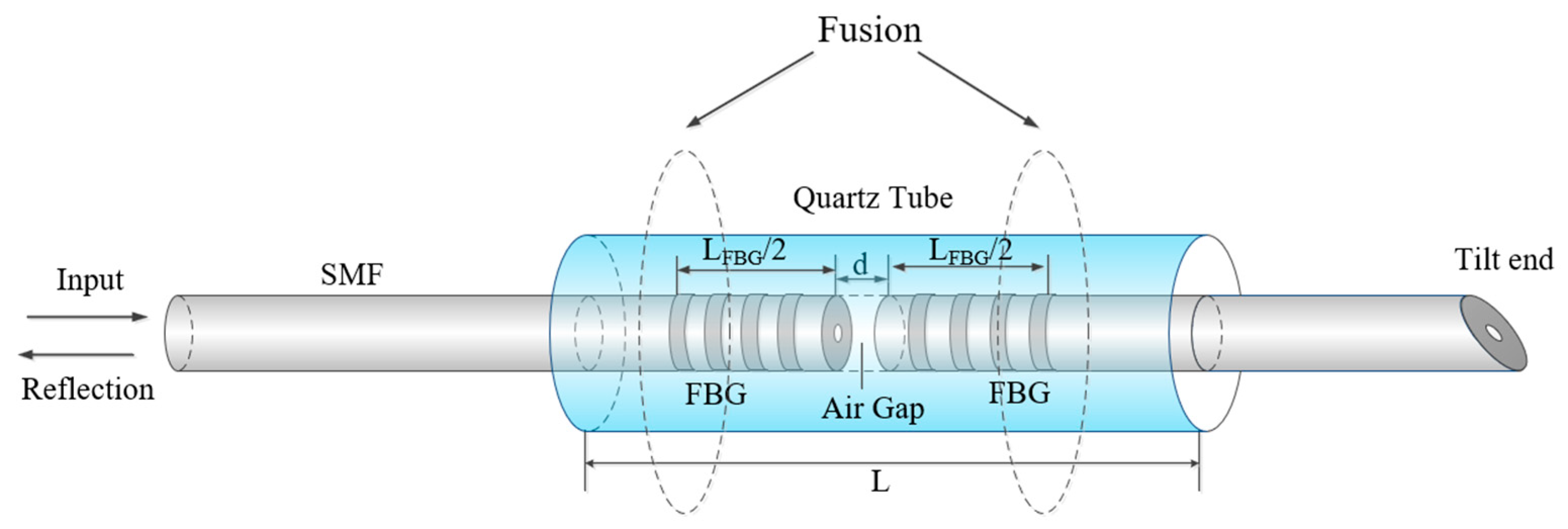
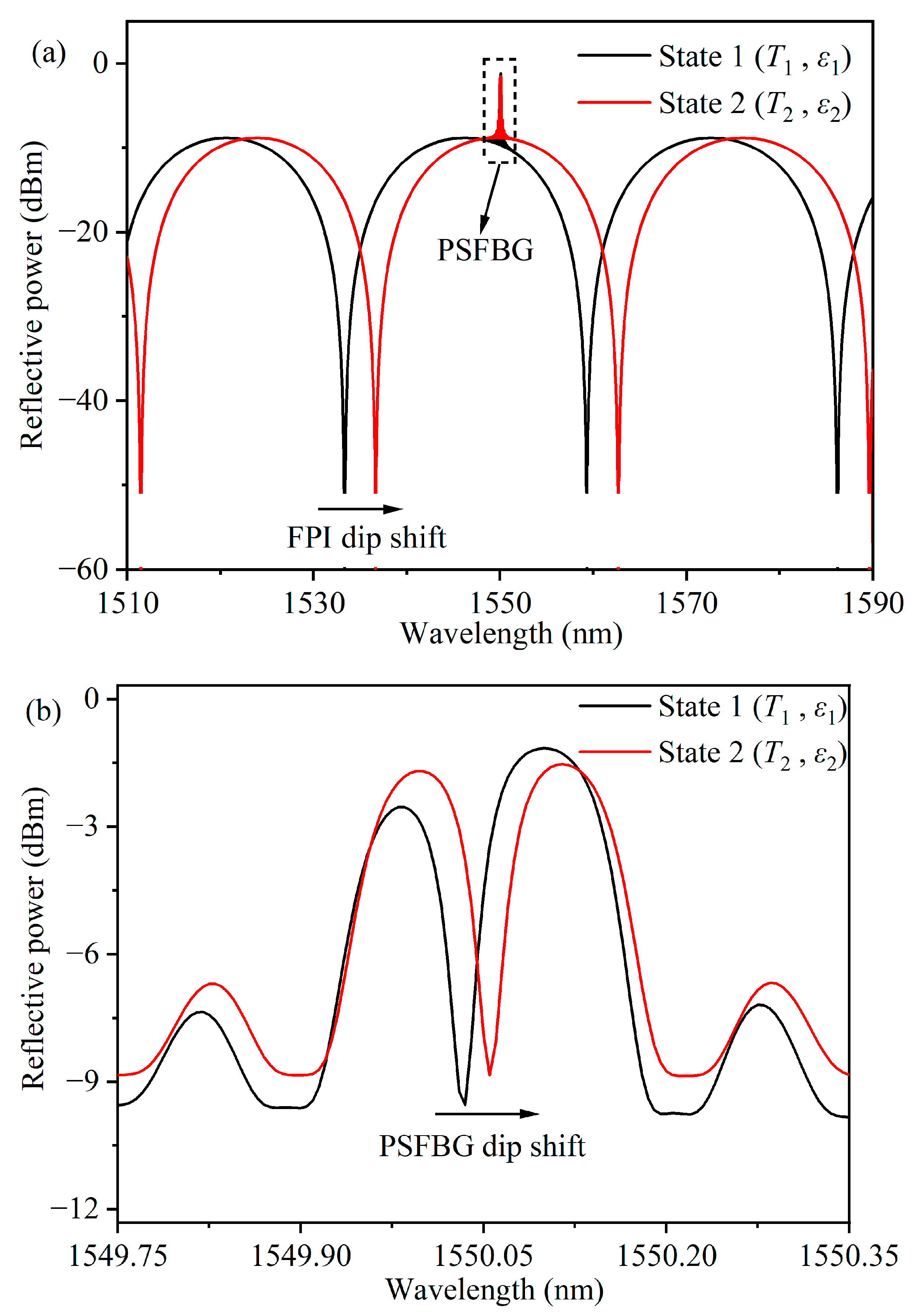

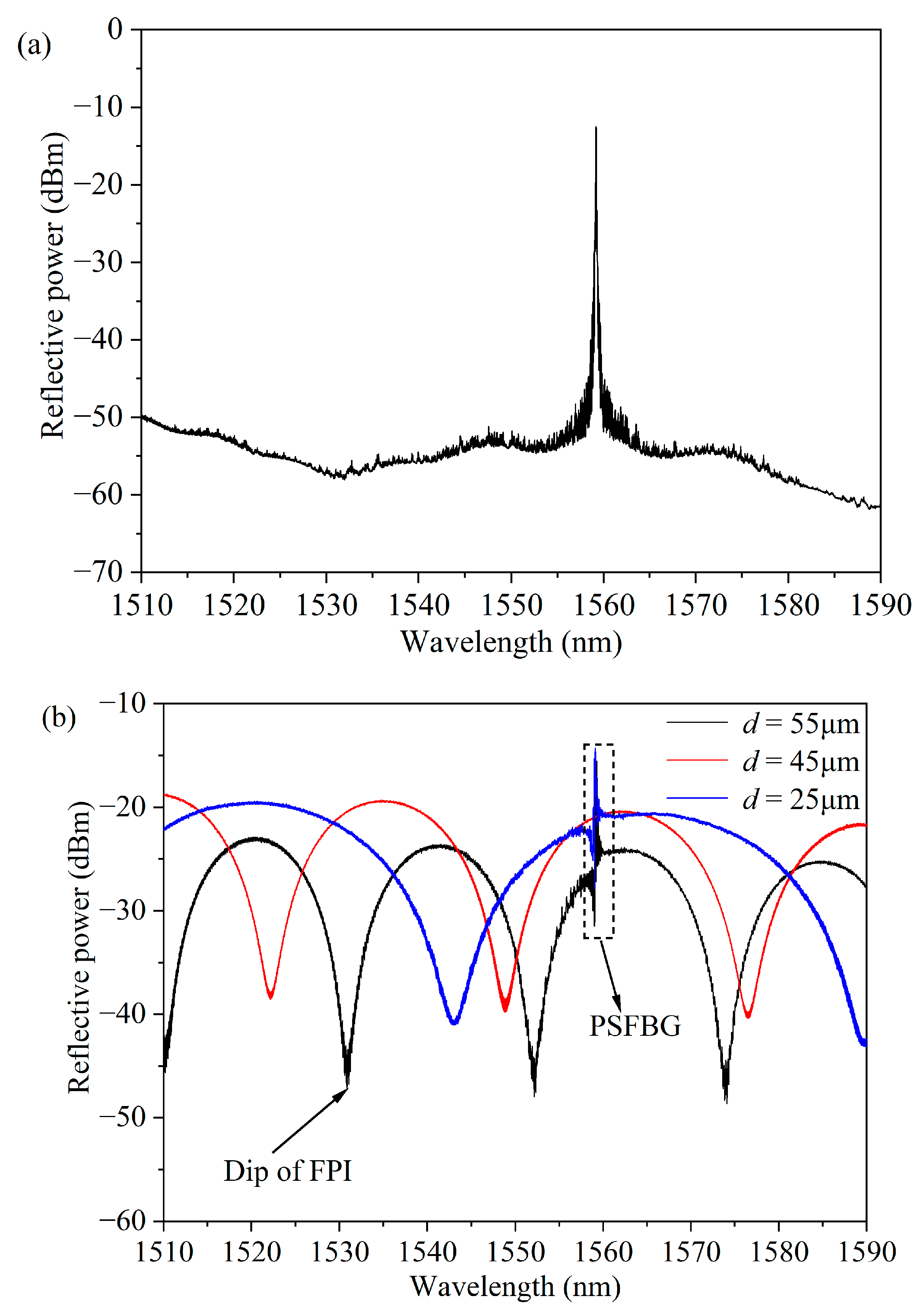

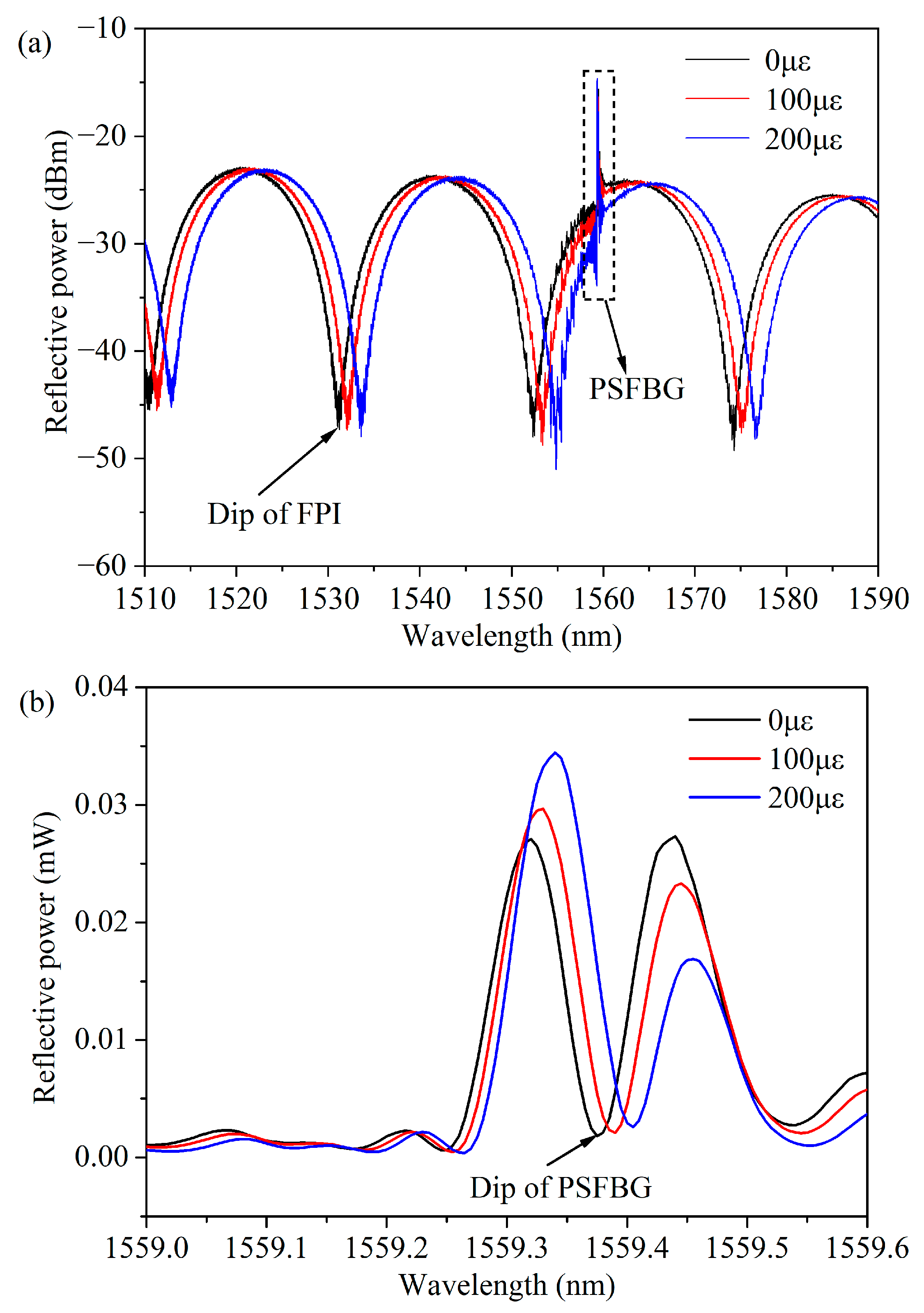
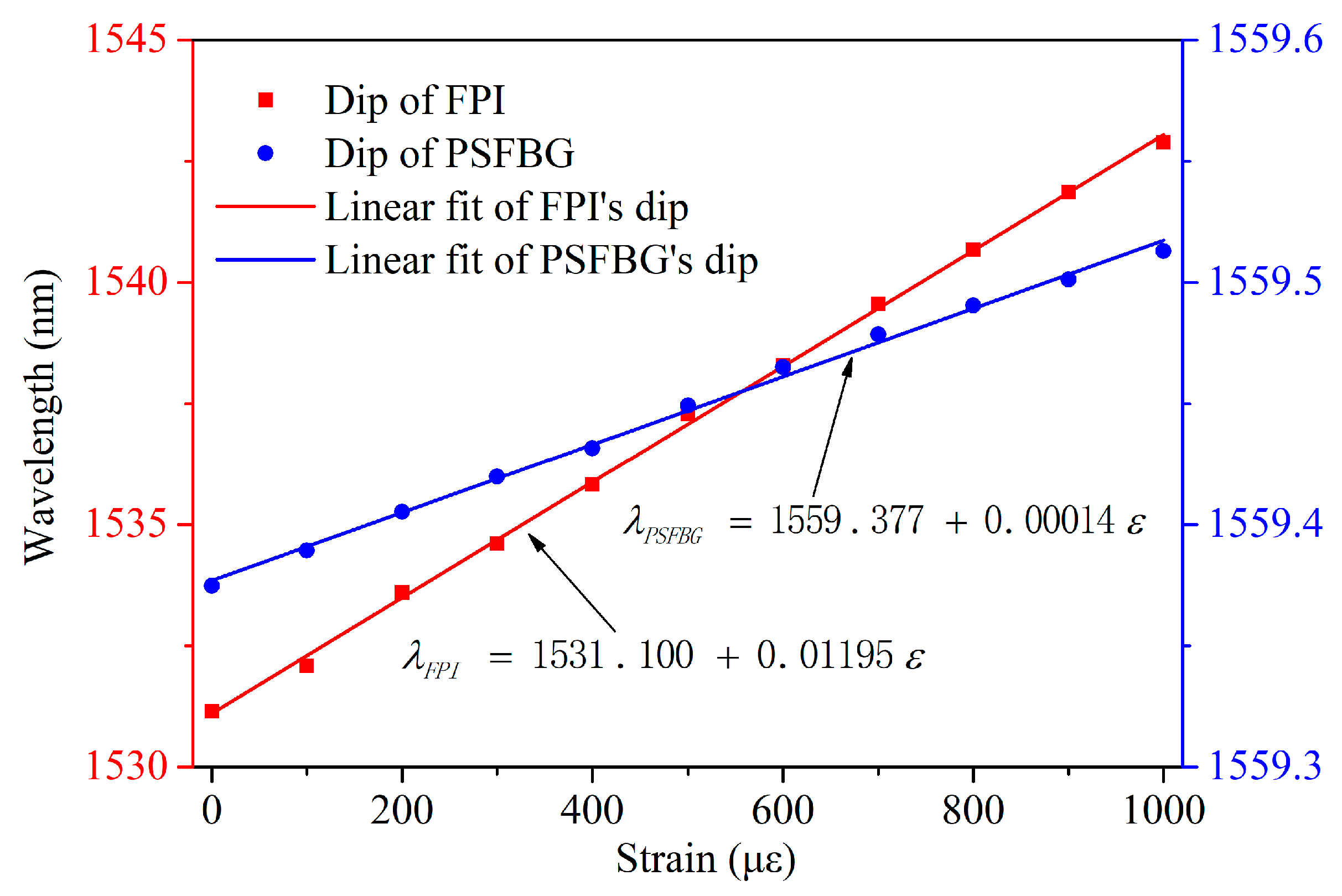
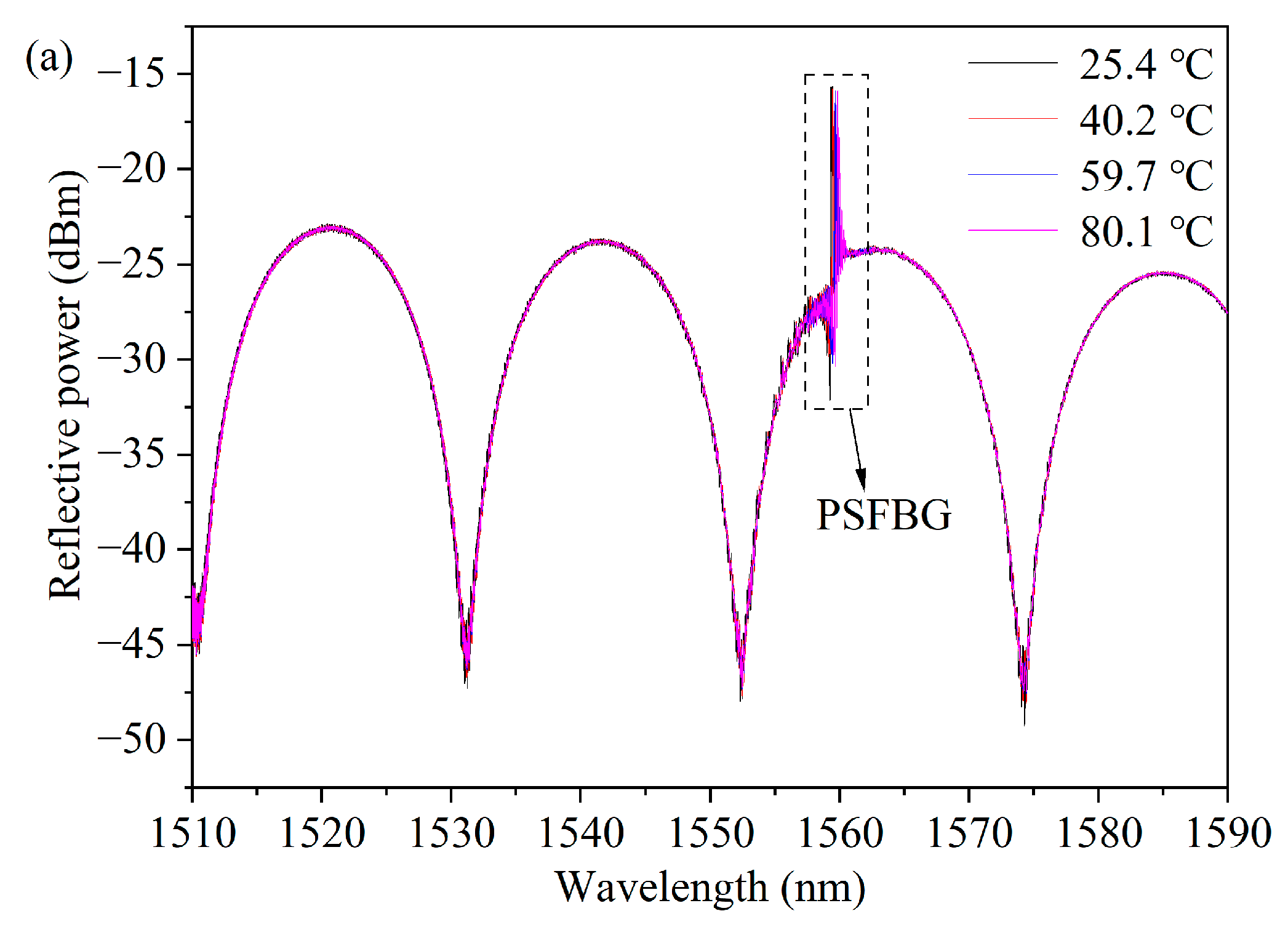
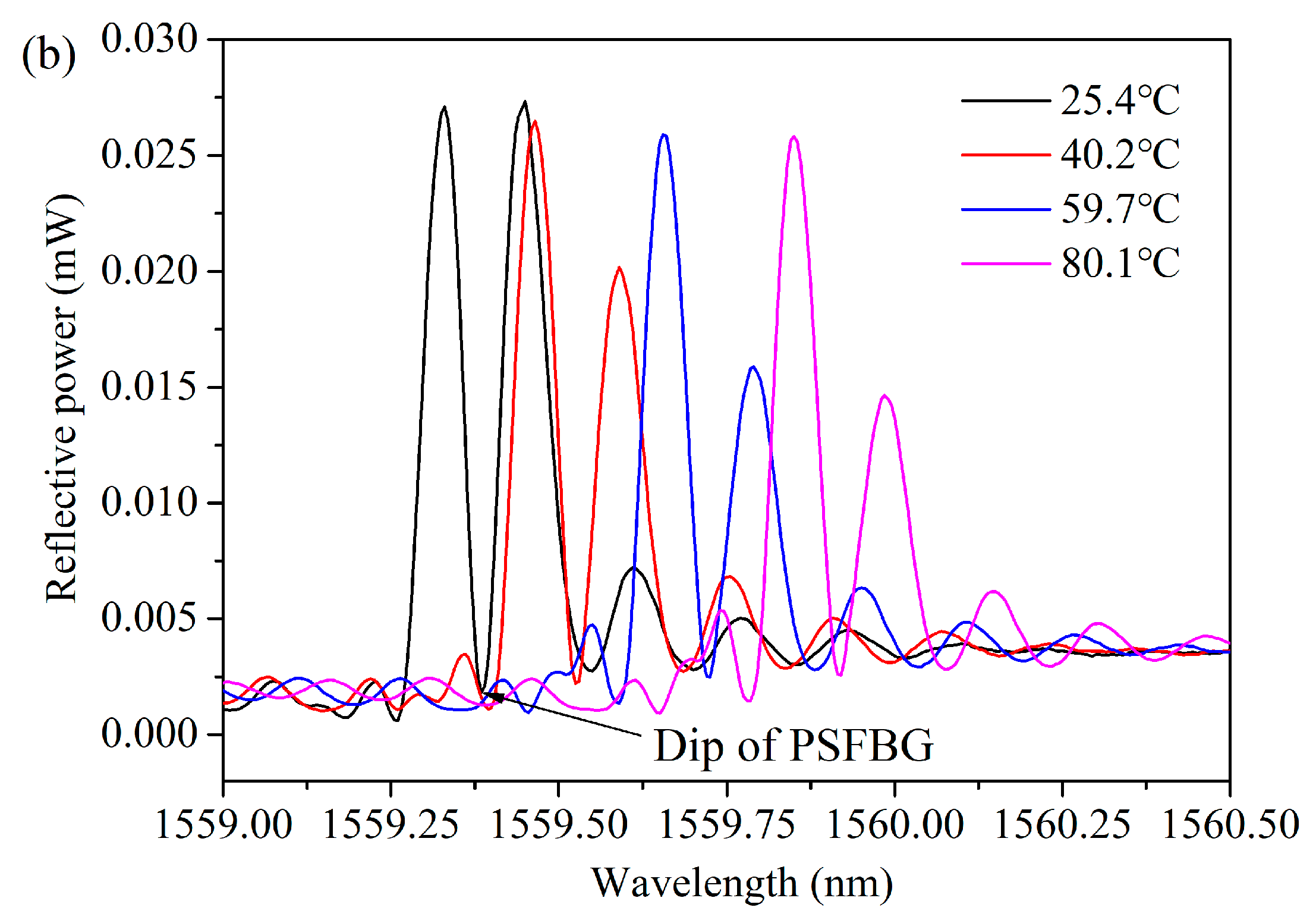
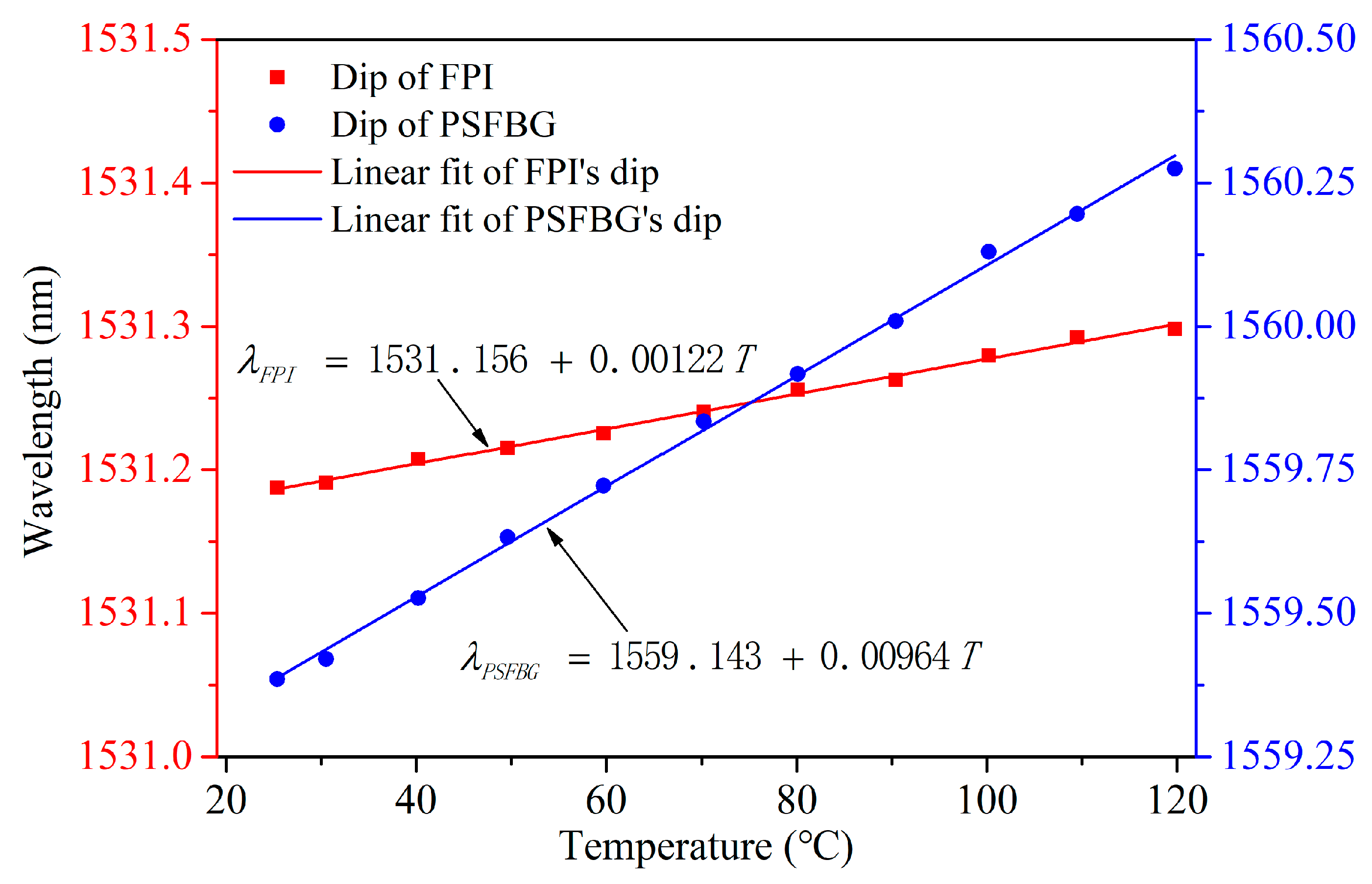

| Configuration | Maximum Strain Sensitivity (pm/με) | Maximum Temperature Sensitivity (pm/°C) | Reference |
|---|---|---|---|
| Dual FBGs sensor | 3.25 | 13.05 | [9] |
| Separated micro-bend long period gratings | −2.41 | 8.8 | [32] |
| Hybrid configuration of FPI/FBG | 2.1 | 7.82 | [33] |
| Cascaded-cavity FPIs | 2.97 | 10.45 | [34] |
| TCF based in-fiber MZI | −1.99 | 54.95 | [35] |
| Spheroidal-cavity-overlapped FBG | 3.76 | 8.4 | [36] |
| Hybrid configuration of EPFI/FBG | Not mentioned | 11.655 | [37] |
| TCRF | 1.08 | 10.4 | [38] |
| Hybrid structure with two FPIs | 5.2 | 13 | [39] |
| Dual SPR effect in PCF | 1.3 | −6.83 | [40] |
| TPMF | −2.37 | 91.84 | [41] |
| Hybrid configuration of fiber taper/LPFG | −2.96 | 47.4 | [42] |
| π-PSFBG sensor | 0.7837 | 14.15 | [22] |
| Femtosecond laser + FBG + DMF | 1.24 | 9.3 | [43] |
| Proposed | 11.95 | 9.64 | This work |
Disclaimer/Publisher’s Note: The statements, opinions and data contained in all publications are solely those of the individual author(s) and contributor(s) and not of MDPI and/or the editor(s). MDPI and/or the editor(s) disclaim responsibility for any injury to people or property resulting from any ideas, methods, instructions or products referred to in the content. |
© 2024 by the authors. Licensee MDPI, Basel, Switzerland. This article is an open access article distributed under the terms and conditions of the Creative Commons Attribution (CC BY) license (https://creativecommons.org/licenses/by/4.0/).
Share and Cite
Yang, F.; Zhu, K.; Yu, X.; Liu, T.; Lu, K.; Wang, Z.; Li, Y. Air Gap Fiber Bragg Grating for Simultaneous Strain and Temperature Measurement. Micromachines 2024, 15, 140. https://doi.org/10.3390/mi15010140
Yang F, Zhu K, Yu X, Liu T, Lu K, Wang Z, Li Y. Air Gap Fiber Bragg Grating for Simultaneous Strain and Temperature Measurement. Micromachines. 2024; 15(1):140. https://doi.org/10.3390/mi15010140
Chicago/Turabian StyleYang, Fuling, Kehui Zhu, Xiaoyi Yu, Tianze Liu, Ke Lu, Zelong Wang, and Yan Li. 2024. "Air Gap Fiber Bragg Grating for Simultaneous Strain and Temperature Measurement" Micromachines 15, no. 1: 140. https://doi.org/10.3390/mi15010140
APA StyleYang, F., Zhu, K., Yu, X., Liu, T., Lu, K., Wang, Z., & Li, Y. (2024). Air Gap Fiber Bragg Grating for Simultaneous Strain and Temperature Measurement. Micromachines, 15(1), 140. https://doi.org/10.3390/mi15010140





